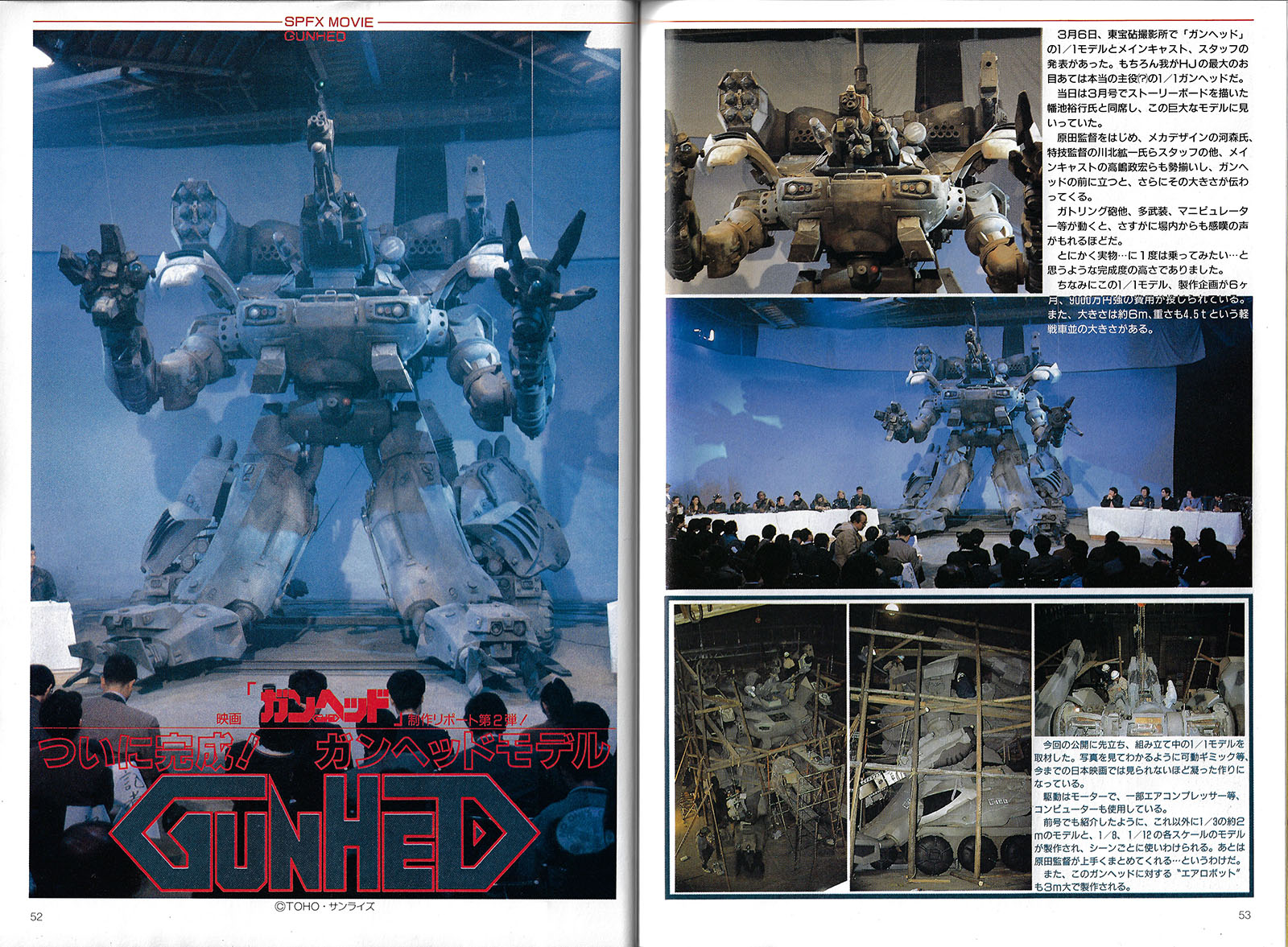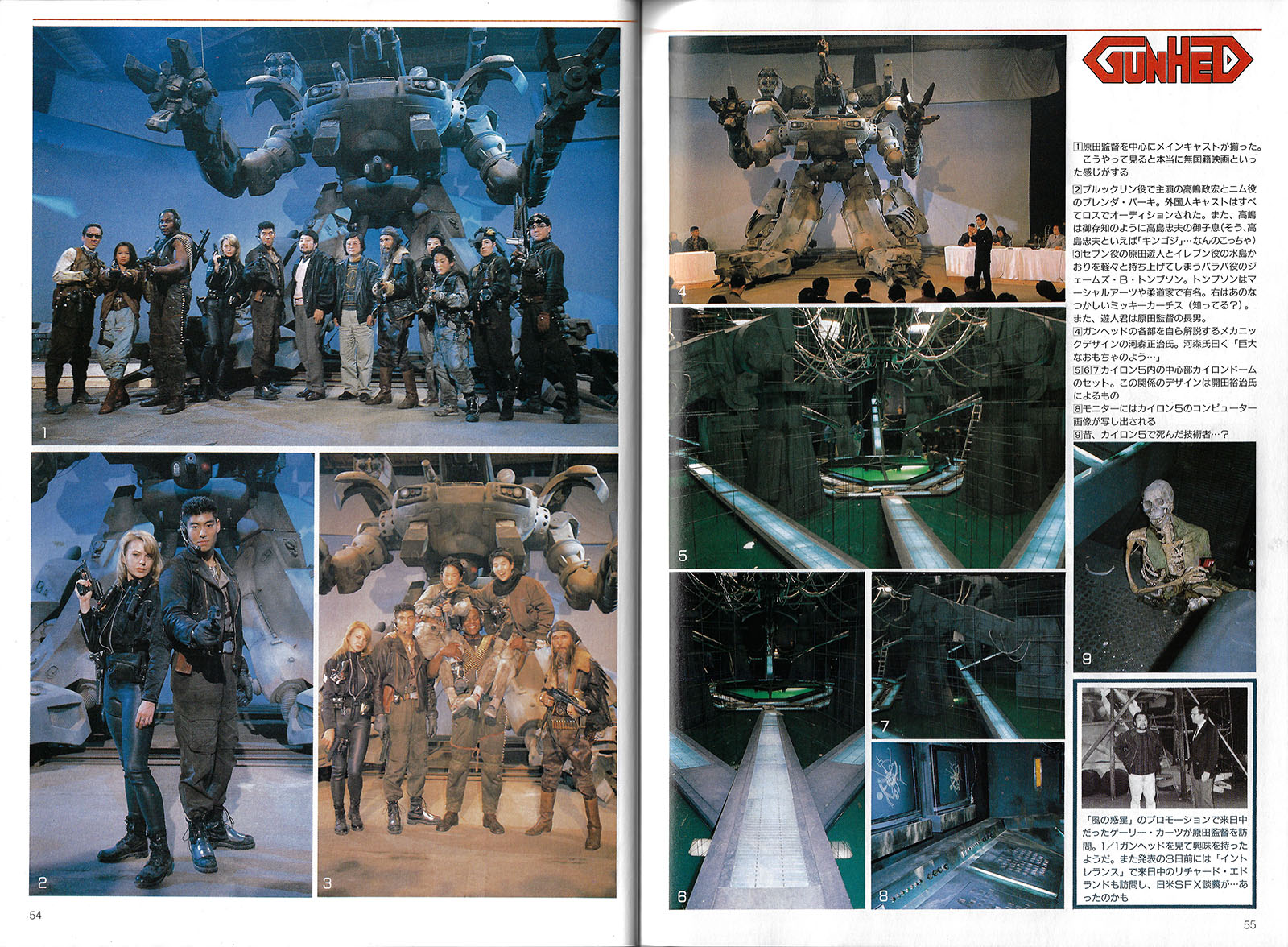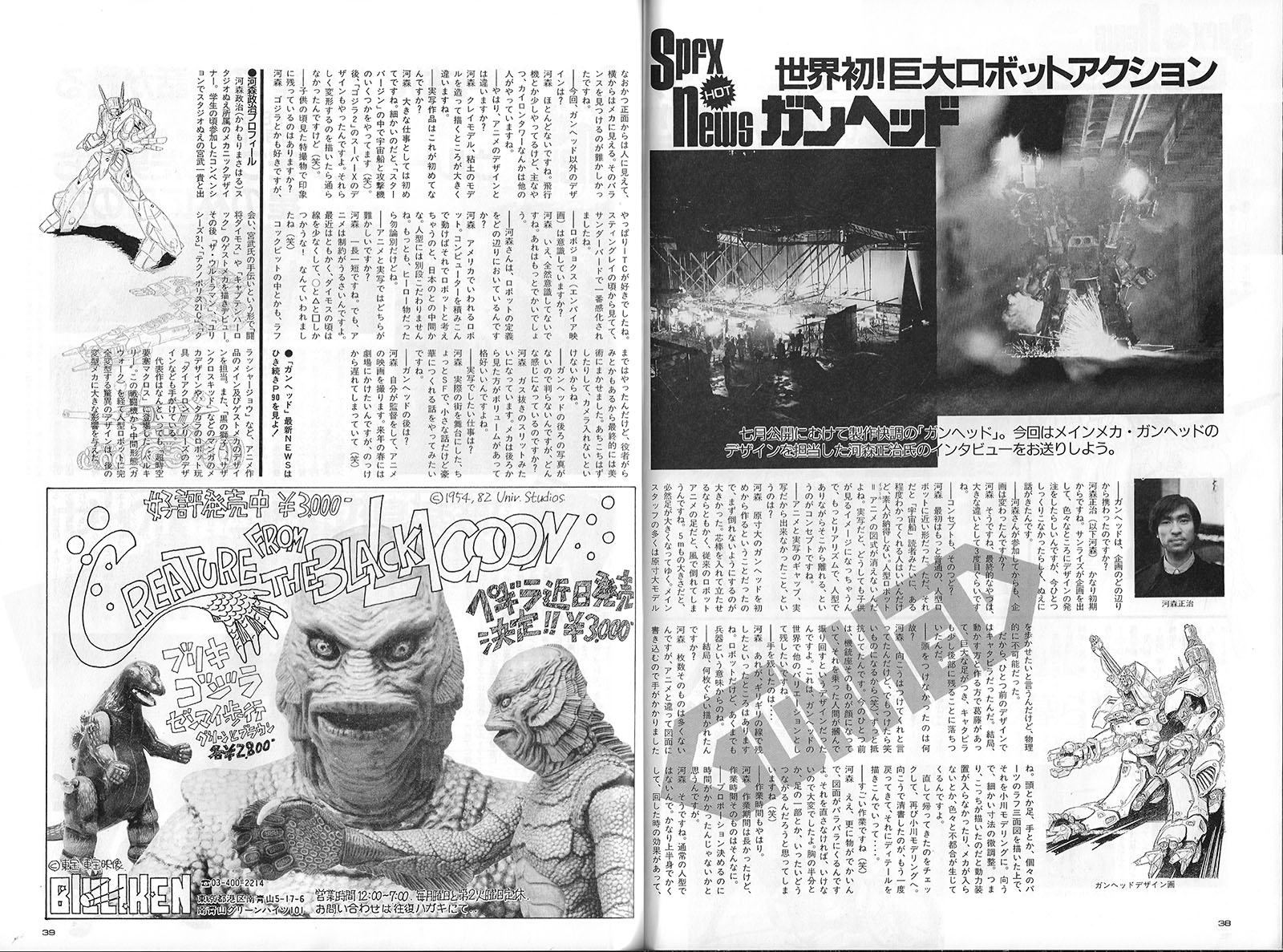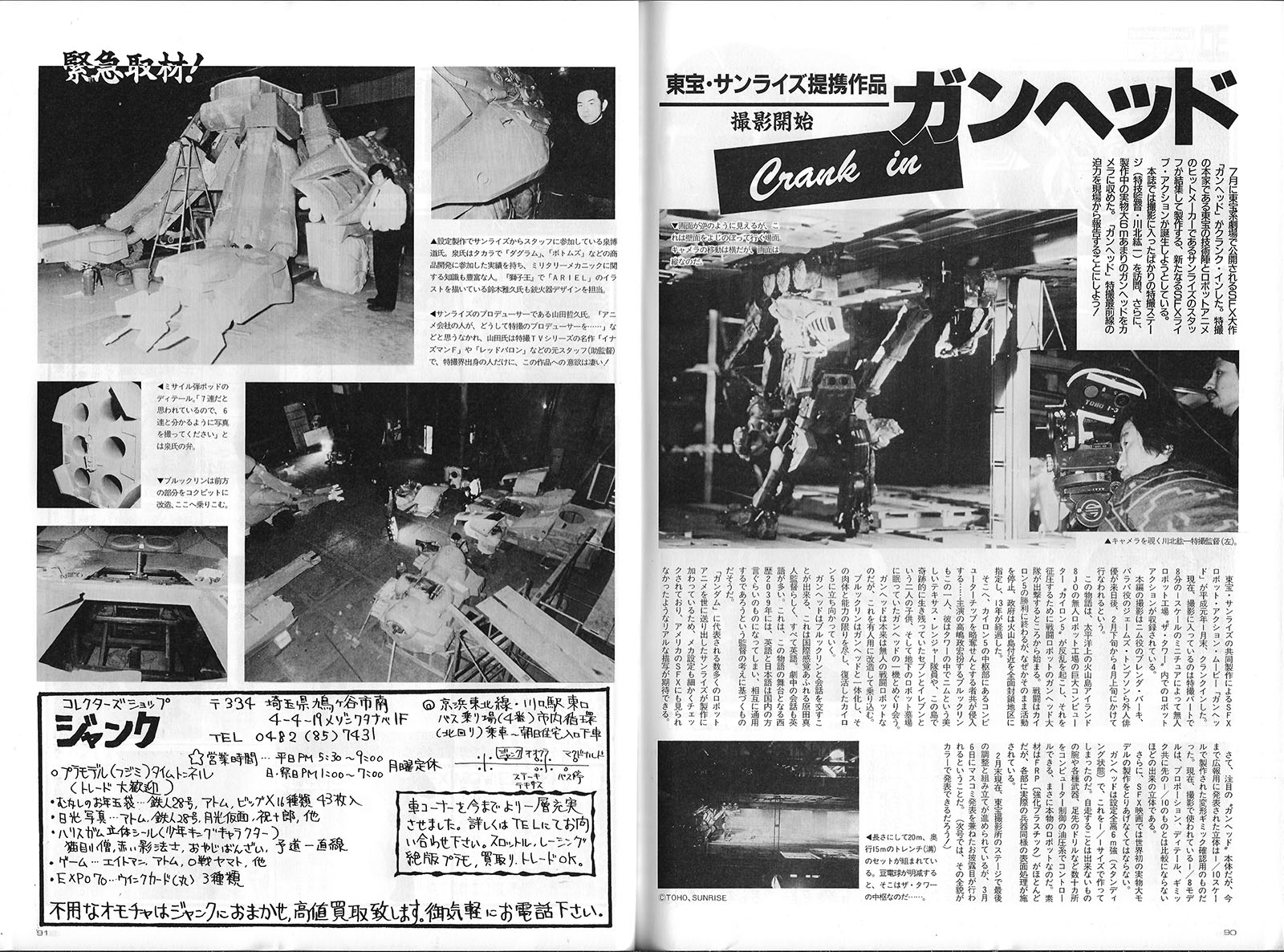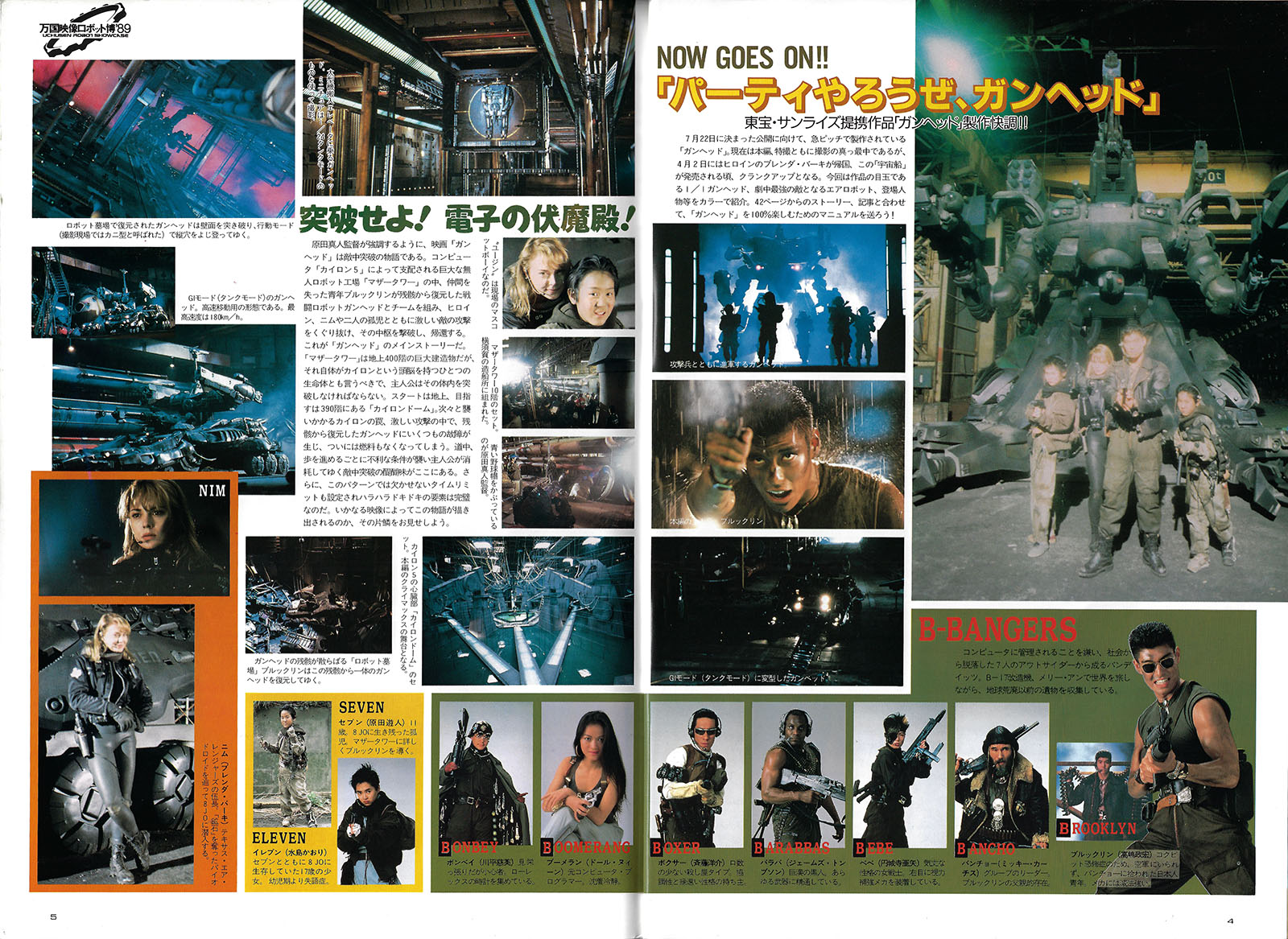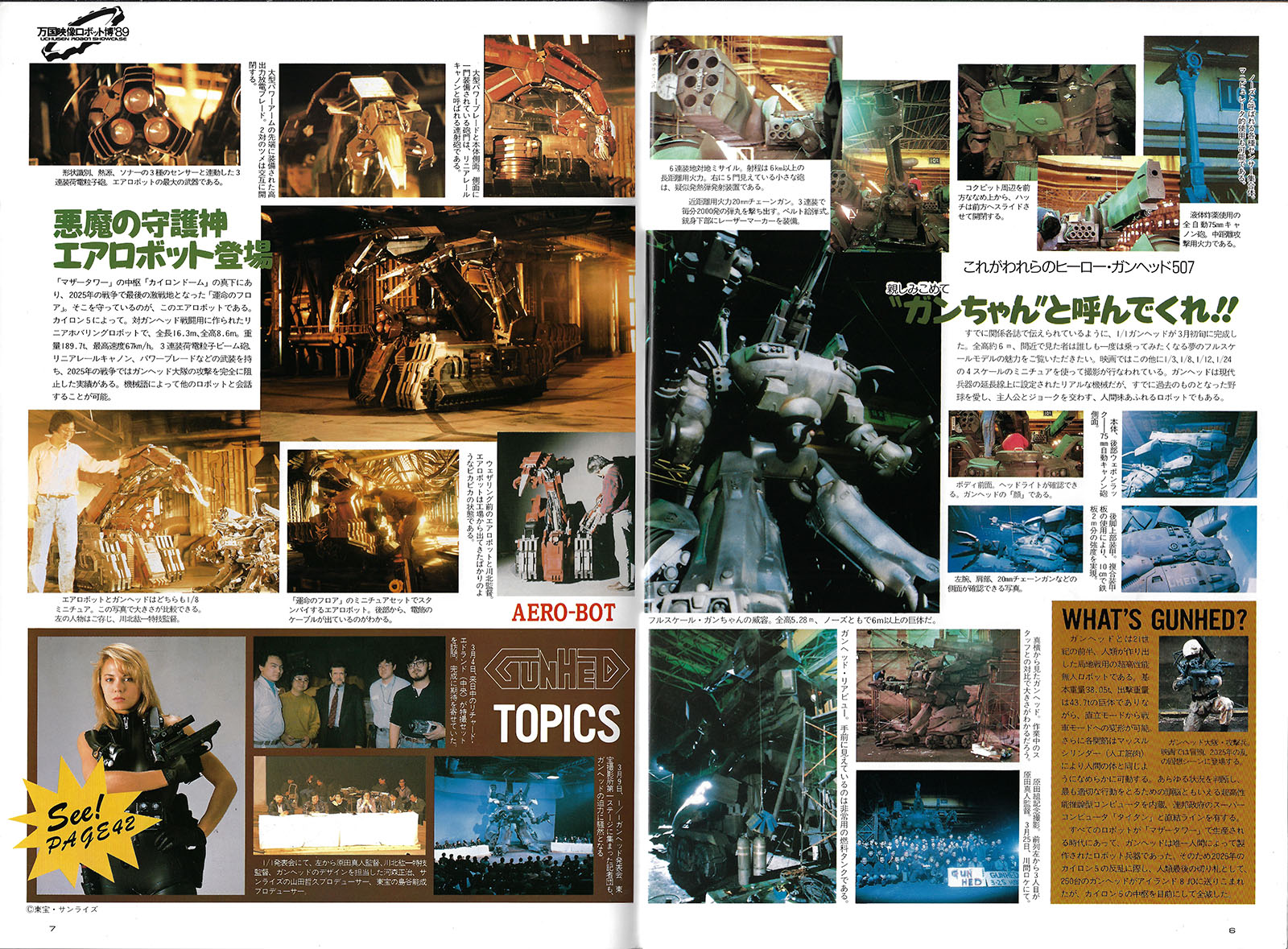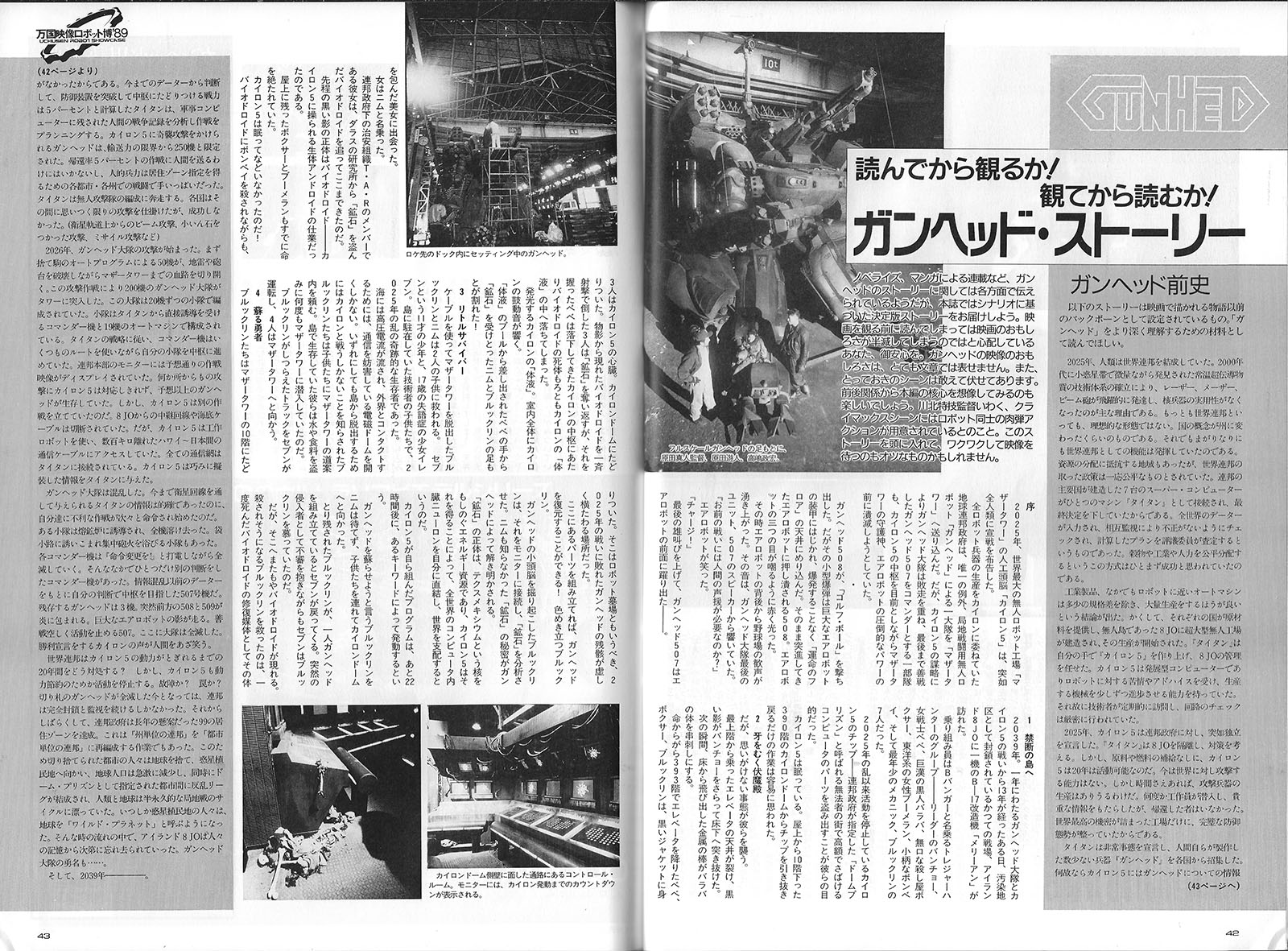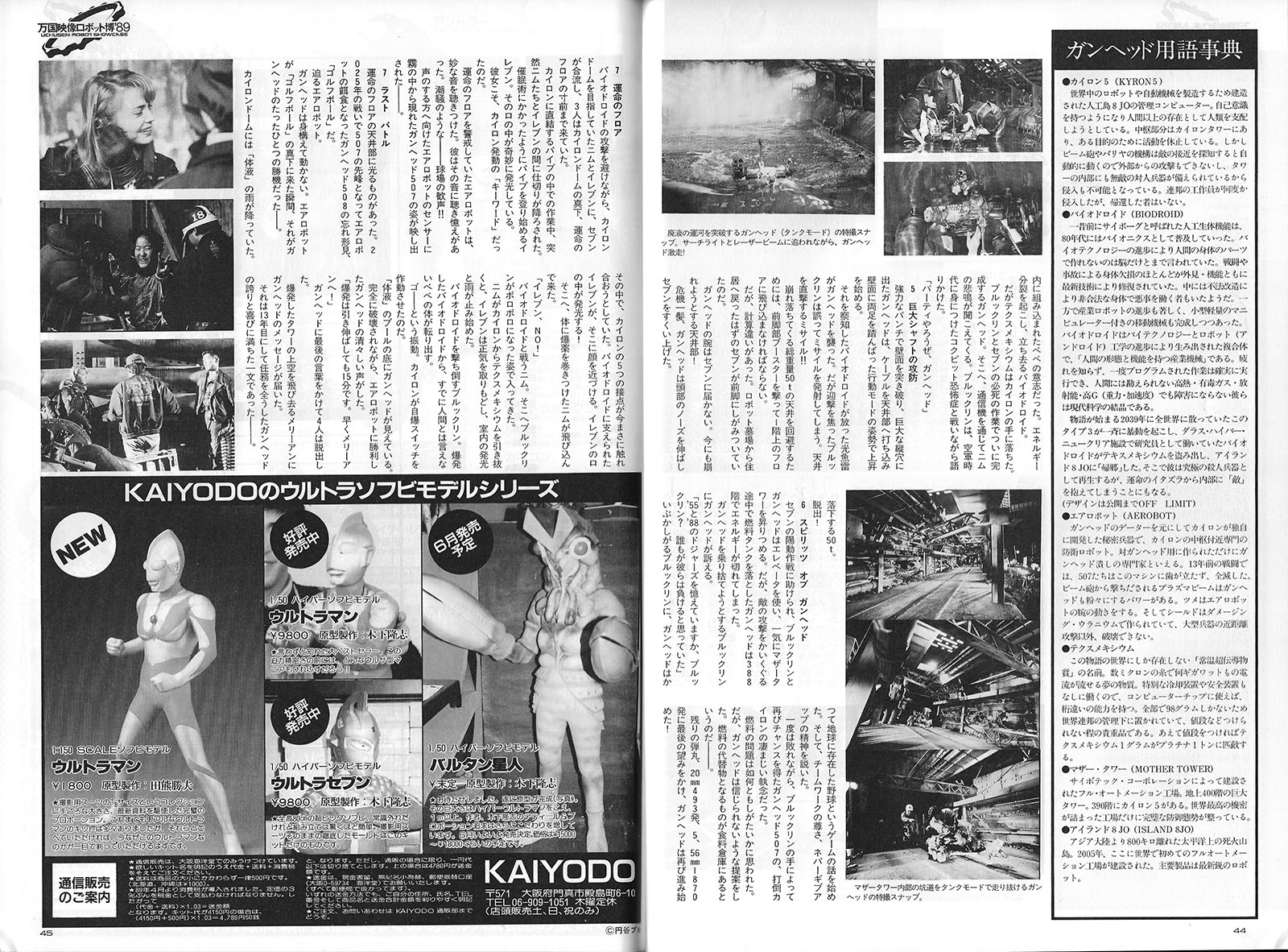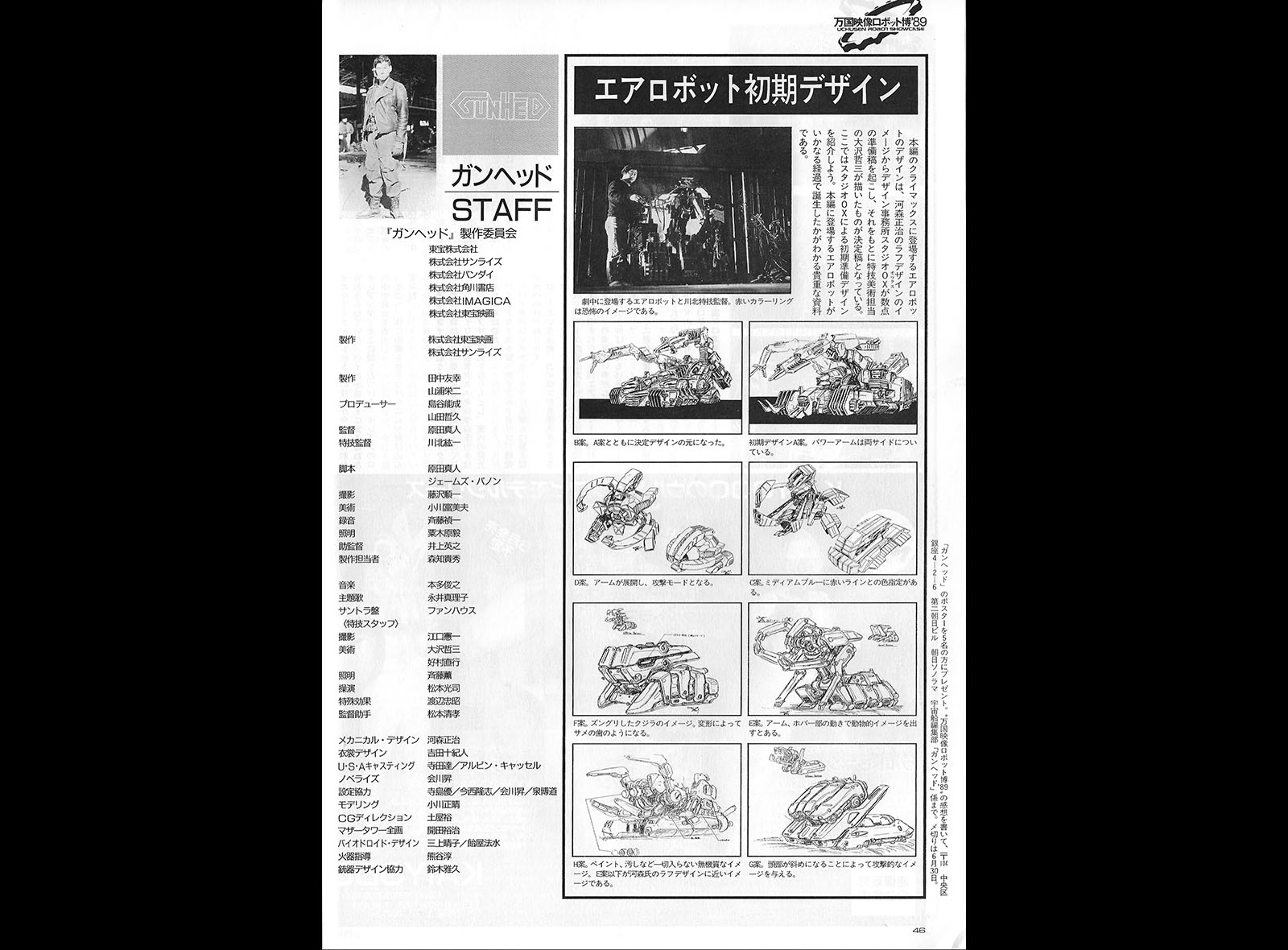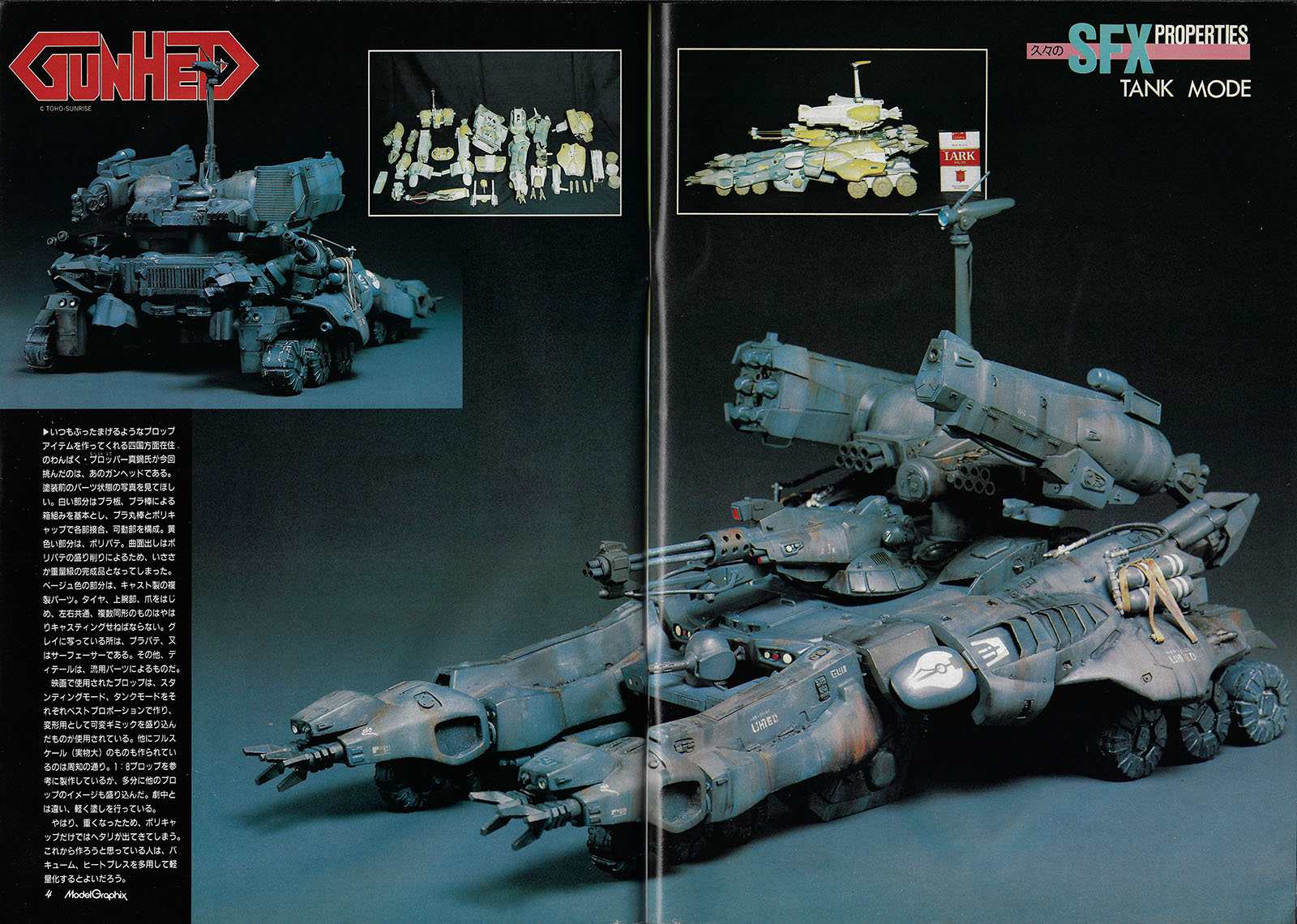Other magazine coverage, 1989
Hobby Japan #239, April
Uchusen Vol. 47, April
Gunhed is in good shape for its July release. Here, we present an interview with Shoji Kawamori, who was in charge of the design of the main mecha Gunhed.
Interviewer: At what point did you get involved in the planning of Gunhed?
Kawamori: From the very beginning. Sunrise came up with the project, and they ordered designs from various companies, but no one seemed to get it right, so they approached Studio Nue.
Interviewer: Did the project change after you joined?
Kawamori: Yes, the final product changed a lot until the third round.
Interviewer: The concept changed each time?
Kawamori: At first, it was more like a normal humanoid robot. That was fine for people who understood it to some extent, like the readers of this magazine, but the average person would not be convinced. Anime robots still have a humanoid scheme, but that becomes a childish image in live-action, so I wanted to move away from that form, to make it more realistic and less humanoid.
Interviewer: What is the gap between anime and live-action, and what couldn’t you do because of live-action?
Kawamori: Since the plan from the beginning was to make a full-size Gunhed, the first thing I had to do was to make sure it wouldn’t fall over. If you put in a core stick to make it stand up, it would fall over in the wind if it had the legs of a conventional anime robot.
The legs of a 5-meter robot would inevitably get bigger and bigger. Many of the main staff wanted to have the full-size model walk, but it was physically impossible. That’s why the early design had caterpillar treads. In the end, there was a conflict between how to build it and how to move it. It ended up with huge legs and the treads remained a little farther back.
Interviewer: Why didn’t you put a head on it?
Kawamori: They wanted me to, but that would have made it a laughingstock (Laughs), so I resisted for a long time. In the design before the finished one, the machine gun seat itself was the face. It was designed for the rider to grab it and swing it around. I would like to leave this as another variation in the world of Gunhed.
Interviewer: You kept the hands…
Kawamori: There were things that I kept up to the very last minute. It is a robot, but only in the sense that it is a weapon.
Interviewer: How many images did you end up drawing?
Kawamori: Not many, but it took a lot of time to draw them, because unlike an anime design, I had to write a lot on the drawings. I did rough three-view drawings of the head, feet, hands, and other individual parts, and then Ogawa Modeling built them. Fine-tuning of the dimensions happened after that. Various inconveniences arose, like a power unit not fitting where I drew it, and so on. After correcting the drawings, I added more details and they went back to Ogawa again.
Interviewer: That’s a lot of work (Laughs)
Kawamori: Yes, things got bigger and the drawings fell apart and I had to fix them, so it was hard. I wondered how half of the chest or part of the leg would be connected (Laughs).
Interviewer: And the work time was also very long.
Kawamori: The working period was long, but the working time itself was not so long.
Interviewer: I seemed to take a long time to decide on the proportions.
Kawamori: Yes, it did. It’s not a normal human figure. The upper half of the body is quite large, and that has an effect when it’s rotated. And it looks like a person from the front and a mecha from the side. It was difficult to find that balance.
Interviewer: What about other designs besides Gunhed?
Kawamori: There weren’t many. I did work on the airplane, but the main ones, such as the Kyron Tower, were done by other people.
Interviewer: Is it different from anime design?
Kawamori: The main difference is that I create clay models and draw them.
Interviewer: Is this your first live-action work?
Kawamori: This is the first time for me to work on such a major project. I have done smaller ones, such as the spaceships and attack planes in Star Virgin. (Laughs) I also designed the Super X for Godzilla. I drew one that transformed, but it didn’t pass. (Laughs)
Interviewer: Are there any tokusatsu movies you saw as a child that left a strong impression on you?
Kawamori: I like Godzilla, but I really liked ITC shows. I started watching around the time of Stingray, and was most inspired by Thunderbirds.
Interviewer: Are you aware of Robot Jox?
Kawamori: No, not at all. It’s probably much bigger.
Interviewer: What is your definition of “robot”?
Kawamori: I think it’s somewhere between the Japanese definition and the American definition. I’m not particular about humanoid robots. But, of course, if it’s a hero, that’s different.
Interviewer: Which is more difficult, anime or live-action?
Kawamori: They have their advantages and disadvantages. But anime is very restrictive. I don’t know about recent years, but when I was working on Daimos, I used fewer lines. I was told to use only circles, triangles, and squares. (Laughs)
I did some work in Gunhed’s cockpit, too, but only in the rough stage. In the end, I left it to the art direction because of the actors. I had to remove things here and there to put in the camera.
Interviewer: I don’t have a picture of the back of Gunhed, so I don’t know what it looks like.
Kawamori: It has slits for venting. Mecha has more volume when viewed from behind and looks cool.
Interviewer: What other kind of work do you want to do in live-action?
Kawamori: I’d like to make a little sci-fi story set in a real city. Something small but gorgeous.
Interviewer: After Gunhed?
Kawamori: I will direct and make an anime movie. I’d like to get it into theaters next spring, but it’s been delayed ever since it started. (Laughs)
See Kawamori’s credit list at Anime News Network here.
Read more about him at his Wikipedia page here.
Uchusen Vol. 48, June
Model Graphix Vol. 58, August

